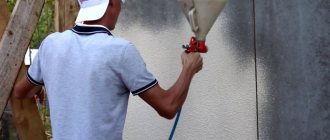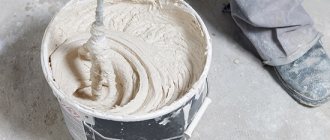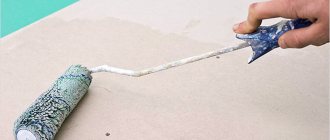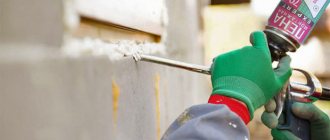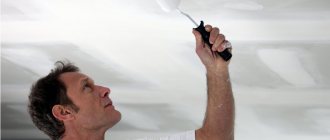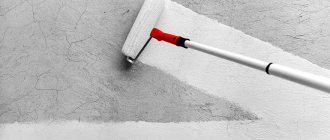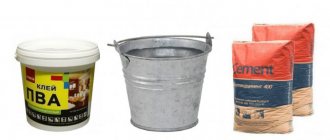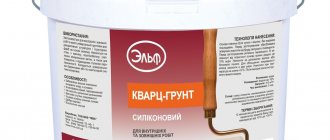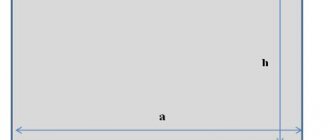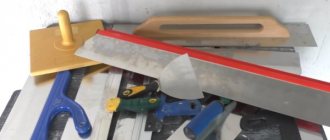Primer consumption per 1 m2 of wall is the basic parameter for the distribution of material when processing the working surface. How much primer is required is determined by the criteria for their purpose and the type of surface being treated: for metals, for wooden surfaces, universal, special. Each of these types is manufactured in accordance with GOST, which requires a certain color texture, primer density, viscosity, and drying time for each type. The indicated parameters determine the proportion of calculation of the material in question.
Primer consumption rates
You should know that with low consumption, the cost of the primer mixture is significantly less than paint and wallpaper glue.
What determines primer consumption?
The material of the treated surface is the main factor influencing costs - porous ones will require more, for smooth ones very little is needed;
- A set of components for the primer itself;
- Properties of the material for further application;
- Environmental conditions;
- The level of professionalism of the master;
- Number of layers applied.
The choice of tool plays a big role in the amount of coating applied: spray gun, brush or roller. Lower costs when working with a spray gun, the highest costs when working with a roller.
Primer selection
Usually the packaging indicates what kind of work the liquid is intended for and the primer consumption. To decide which composition is best to choose, it is necessary to familiarize yourself with this information. The primer must have the following basic characteristics:
- Good penetrating ability.
- Increase the adhesion of the base.
- Bind dust.
- Resistant to chemical influences.
- Not toxic.
- Ensure continued uniform application of the finish.
- Reduce consumption (per 1m2) of paint or wallpaper glue.
- Dry quickly.
It must be a moisture-resistant and heat-resistant liquid. Typically the primer is a white or colorless composition. Some white liquids become yellowish after drying. Therefore, you should know what kind of finishing the walls are planned with gypsum plasterboard.
For example, a colorless solution of Ceresit 17 is often used for priming drywall for further painting. When you plan to glue wallpaper, you can buy a white solution (if the coating is paper, then it is better to choose a colorless solution). Before painting, it is necessary to apply a colorless primer (it is recommended to choose the “Universal” option).
When choosing a solution, it is recommended to give importance to:
Indoor drywall tile primer should be used for interior work. You cannot use façade; it contains substances prohibited for work in residential and public buildings. It is not always recommended to use universal formulations. To get the best results, you should better choose special solutions.
Stages of priming plasterboard walls
The use of different types of compositions leads to the fact that less materials are wasted, and the finish lasts better. Which liquid works best and where is easily determined by the chemical composition of the solution. This factor determines the surfaces on which the composition is most effective.
Types of primer
Deep penetration is used on loose, fragile surfaces for more reliable fastening
- After application, the surface becomes smooth, porosity is reduced due to soil absorption.
- The cost will be high, but the volume of finishing material will be significantly reduced.
- Such compositions are used to cover plastered walls, wood, chipboard, MDF or similar materials.
Surface primers include acrylic and façade primers. Available in powder form or ready-to-use form. They are white in color and go well with light-colored surfaces. The volume is up to 150 g per square meter. m. Surfaces primed with acrylic composition are ideal for painting with acrylic paints.
Characteristics of various brands
The primer has an excellent ability to penetrate the surface of the treated element, reduces moisture absorption, levels, strengthens surfaces, and increases the adhesion of materials. In addition, it protects surfaces from fungus, mold, and dampness, and it also minimizes the absorption of raw materials, helping to save wallpaper glue or paint. Some mixtures contain special antifungal ingredients that prevent this problem from occurring .
There are many different types of primer on the market now. It differs in scope and cost. The most common are:
- Concrete contact: Has excellent binding ability, necessary for dense, poorly absorbent surfaces to prepare them before applying plaster or laying tiles.
- Deep penetration primers. Used to strengthen crumbling foundations.
- For decorative plasters. Apply as a base before subsequent application of plaster.
- Alkyd. Used for processing partitions made of fiberboard, chipboard, wood, and plasterboard. They are considered universal for various bases.
- Water-dispersed ones are used to prepare the surface before painting.
- On an acrylic basis for facade work.
- Primer for wallpaper. Usually a ready-made solution is sold in canisters. In some cases, glue is used instead of a special product.
- Products for wooden and metal substrates. Used before coating with enamels.
- Special anti-corrosion: for pre-treatment of ferrous metals before painting.
- Universal, brand "Optimist": used for different bases. They are a combination of different types of primers.
- VL-02 for metal surfaces. Used for body work.
It is not recommended to use products intended for one type of surface when working on another type. For example, a wallpaper primer will be useless for metal work.
Primer Types
- Acrylic primer is universal, suitable for any type of surface.
- Latex is good for covering wooden walls - it perfectly protects against moisture.
- The silicone composition is intended for indoor and outdoor use and has water-repellent properties.
- Silicate or “liquid glass” tightly closes the pores of plaster and silicates and is used before painting.
- Shellac is used to treat raw, resinous wood.
- Polyurethane primer is used to cover concrete bases, metal and ceramics.
- Alkyd is used for application to plaster, glass, chipboard or metal.
- Epoxy increases the strength of the coating.
- Due to its toxicity, perchlorovinyl primer is intended for external use.
What are primers used for?
The primer penetrates the surface layers of the material, strengthens them, improves the adhesion of the material, and compacts it. In addition, primers reduce the absorbency of the material and thus save you paint or wallpaper glue. Some primers contain special antifungal agents and thereby protect you from this trouble. If you want your renovation to last for years to come, you simply need to use primers.
Different types of primers are used for a variety of jobs, for different materials. Currently, there is a rich palette of different primers for any occasion. They are different in composition and may contain various oils, resins, pigments, and varnishes. Primers are available for metal and wood, special or universal. Modern primers differ in their viscosity, density, color and drying time.
Flow rate
Manufacturers of building materials always indicate usage standards on the packaging. But the factors discussed above indicate the impossibility of an absolutely accurate calculation.
The average consumption rate (per 1 sq. m) ranges from 10 grams per square meter to 300, depending on the composition of the components and the manufacturer.
Why apply primer to walls?
There are many finishing operations that require special preparation of the ceiling and wall surfaces. Preparation is carried out by applying a primer composition to the base.
Deep penetration primer is often used
The base is treated with primer in the following cases:
- before painting the surfaces of walls and ceilings;
- when finishing metal, wood and plasterboard surfaces;
- if necessary, apply protective and decorative plaster;
- to ensure reliable wallpapering.
The primer composition penetrates deep into the material through capillaries, seals the pores, increasing the strength properties and ensuring the integrity of the base.
Treatment with a primer mixture is a serious finishing operation that provides:
- deep penetration of soil into layers adjacent to the surface;
- increasing the adhesion of the finishing material to the surface;
- reduction of absorbency of the treated surface;
- significant savings in wallpaper glue and various paints;
- reliable protection against the development of microorganisms;
- long service life of the painted base;
- increasing the density and strengthening the processed base.
The primer composition ensures the integrity of the base.
In order to ensure the durability of the decorative finish applied during the repair process, it is advisable to use primer compositions. They also make it possible to significantly reduce the cost of purchasing adhesive mixtures and binders. Various types of primers are used for processing wood, metal, as well as compositions and mixtures for special purposes.
Soil consumption varies depending on the type of base being treated. Using a regular calculator, it is easy to calculate soil requirements on your own.
Consumption of deep absorption primer
The costs of such material are significantly higher than other types due to the unevenness of the object. But considering that the structure being treated will subsequently require significantly less expensive paint, the benefits are undeniable, even if it is primed in several layers. The quality of coloring will be high.
You will have to spend up to 180 g per meter.
Priming functions
Priming improves a number of characteristics of the base intended for subsequent finishing:
- A waterproofing film is formed on the surface.
- The adhesive properties of the surface are improved.
- The top of the material is significantly strengthened.
Applying a primer before filling gypsum board sheets increases the service life of the surface and significantly reduces the degree of water absorption. Some types of solutions contain antibacterial additives. Then the composition protects surfaces from the effects of fungi, mold and other bacteria.
Drywall must be primed, then the putty will apply better. Pre-treatment increases adhesion to finishing materials.
Due to the improvement in the properties of bases coated with the composition, there is a reduction in the consumption of putty for drywall, paint, and decorative plaster.
Scheme for applying primer to a plasterboard ceiling
A deep penetration primer provides drywall with many years of service without losing its properties. Antibacterial additives present in the solution improve the atmosphere in the room and prevent the development of pathogenic fungi and mold. Therefore, it is recommended to use such compounds to treat places to which access will be closed after the installation of plasterboard structures is completed (reinforced concrete floors, walls).
Acrylic primer consumption
The building material is sold in two types: Dry and ready-to-use.
The dry mixture will have to be diluted with water in the proportions specified by the manufacturer on the packaging.
- After this, the solution can be applied to the surface, which in the future will have light shades: the color of acrylic is white.
- The average rate varies from 130 to 150 g per square meter.
- Acrylic mortar can be used to cover not only walls, but also floors and ceilings.
Calculation formula and calculator
You can calculate the amount of material. To do this, calculate how many liters are in one kilogram. You can find GOSTs and tables - the numbers in them are indicated in kg/m3. You can also simply find the weight of the desired product. For example, GF 021 – 1 l = 1.47 kg. The weight of one liter is often indicated on the packaging.
Here's how to calculate the required amount of material: take the coverage area, the average value (indicated on the package) and multiply. This is how the total amount of material is calculated. It should be added to this calculation that the indicators are calculated for one layer. If more layers are needed, then the total figure is multiplied by the number of layers.
To simplify the calculation of the required amount of primer, use the calculator.
Priming the walls allows you to properly prepare the surface. And something more needs to be said about this. If there are doubts about the amount of material, then you should not purchase more than you need. It is better to buy more if necessary than to store for the future. Any composition has its own shelf life and soils are no exception.
Tips for choosing a primer (2 videos)
Various primer mixtures (30 photos)
Primer consumption for metal
Metal processing requires a substance with anti-corrosion properties.
- Obviously, water-based mixtures cannot be used.
- A good option would be to use GF-021.
- The metal surface should not have rust, then the cost of the solution will be very small.
- The mixture includes epoxy resin, so it can be used on concrete and other non-porous materials.
For 1 sq. meter of wall is enough 110 g, on an unprepared plane the use will increase.
How to calculate primer consumption per 1 m2 of wall
Primer consumption per 1 m2 of wall is the basic parameter for the distribution of material when processing the working surface. How much primer is required is determined by the criteria for their purpose and the type of surface being treated: for metals, for wooden surfaces, universal, special. Each of these types is manufactured in accordance with GOST, which requires a certain color texture, primer density, viscosity, and drying time for each type. The indicated parameters determine the proportion of calculation of the material in question.
Consumption of latex primer
Artificial latex has good elasticity and water-repellent properties, but adhesive qualities are low. Used for loose and crumbling coatings: wood and composite materials.
Dries in 40 minutes, and can be painted an hour and a half after application. Average consumption is up to 220 g per square meter. meter.
Purpose of the primer
The purpose of soil mixtures is to strengthen the walls or ceiling being treated, as well as to increase their density. They make it possible to save money on consumables by minimizing material absorption. After treatment with primer mixtures, the consumption of paint or wallpaper glue decreases. Plus, it has moisture-proof properties and the ability to prevent cracks.
Some types of primers contain elements that help prevent fungus, and the effectiveness of such elements is so high that fungus and bacteria do not penetrate the surface. This mixture is an excellent way to preserve a renovated home for a long time.
Each type of soil solution has its own specific role, and their many varieties make it possible to expand the scope of application. They differ in their composition, which can be supplemented with oils, resins, varnishes, etc. There are separate types for wood and metal. Special and universal soil mixtures are also widely represented.
All types have distinctive features, including:
- degree of viscosity;
- different levels of density;
- color spectrum;
- different drying times.
It is based on these characteristics of soil products that it is necessary to correctly calculate the primer consumption per m2.
Silicone primer consumption
Refers to deep penetration compositions. Not very common due to poor adhesion to various substances - it contacts well with silicone-based materials. The composition protects well from moisture, fungus, and mold. Suitable for outdoor and indoor use. The approximate consumption ranges from 150 to 250 g per square meter. m.
Silicate soil mixtures: Quantity per 1 sq. meter.
Calcium silicate or “liquid glass” has many excellent qualities, but is subsequently used only with silicate-based paints. The range in quantity is 150-300 g per square meter. m.
- Consumption for concrete is 200-300 g per square meter. m.
- Antifungal treatment protects against fungus and mold and is used for various surfaces. Consumed within 200-300 g/sq.m. m.
- There are no consumption data for frost-resistant primer. It is used for various purposes.
- It will take about 100 g per square meter to impregnate drywall. m, but it all depends on the manufacturer.
- The most common coating is plaster. You can’t do without applying a primer mixture to it, because neither paint nor wallpaper glue sticks to the plaster.
The average cost will be within 200 g/sq.m. m.
You can make your own primer mixture based on PVA glue, taking into account the costs given above. It is important to remember that by spending some amount on rough processing of walls, you will get savings in the purchase of basic materials and a huge gain in quality.
Consumption of primer mixture per 1 sq. m
Applying a primer mixture is one of the key stages in finishing a room. It doesn’t matter what happens to the surface later: paint, wallpaper or apply a layer of plaster - it all comes down to pre-treating the surface with a layer of primer.
Applying the solution is the cornerstone stage of the entire repair. Although this stage will not affect the final interior of the room in any way, finishing is impossible without it, since this is the first thing any room treatment should begin with. But in order not to make a mistake with the amount of composition purchased, you need to know the approximate consumption per square meter of wall. In addition, without knowing the correct proportions, priming the base will not be possible.
The primer mixture is designed to increase the strength of the walls, as well as for a stronger connection of the finishing material with the base of the floor. It helps to greatly reduce the consumption of paint or wallpaper glue. If there is no solution or very little, they try to replace it with a large number of layers of wallpaper glue or paint and varnish material, which is unprofitable. Another advantage of the primer mixture is moisture resistance - a wall treated with the composition is more resistant to a humid environment than a conventional untreated floor.
Photo: applying the primer mixture
Many primer compositions contain antifungal components, which prevent biological contamination from spreading on the finishing surface. This is a good way to protect your newly made renovation for many years without damaging the finishing elements.
Primer mixtures differ from each other in their purpose. A large number of compositions allows you to select a solution for almost any conditions in which the wall is located. Some mixtures contain oils, varnishes, resins, which directly affects the purpose of the mixture and its properties. There are differences in the following ways:
- type of surface on which the composition will be applied (wood, metal, concrete, etc.);
- degree of universality (special, universal);
- degree of viscosity;
- density;
- color;
- drying time, etc.
The amount of primer mixture used depends on several factors:
- solution quality;
- its operational characteristics;
- the type of primer used;
- quality, characteristics and type of floor surface;
- method of applying primer;
- air humidity;
- temperature conditions in the room;
- number of layers.
So, the amount of primer mixture consumed per 1 square meter of surface is considered one of the important characteristics. The resulting number will be different for different primers - this is directly affected by almost everything that is used as components. The finished mixture must meet the requirements of the state standard.
Below is a list of consumption rates for the most used types of soil mixtures:
- concrete contact – 0.35 kg/sq. m. This primer is suitable for preparatory work on walls with a low level of water permeability;
- deep penetration primer mixture is consumed in an amount of 100 grams per square meter of surface. This primer is used as a reinforcing coating that strengthens initially shaky, crumbling surfaces;
- alkyd primer is considered one of the most universal mixtures, its consumption is 120 grams per square meter. Suitable for processing wood surfaces, plywood and drywall;
- primer composition for working with decorative plaster is a very rare composition, since it is only suitable for working with this type of plastering, its consumption is 0.2 kg/sq.m. m;
- water-dispersed – 100 g/sq. m;
- façade with acrylic base – 0.15 kg/sq.m. m;
- primer mixture for wallpaper is consumed in the amount of 120 grams per square meter;
- a solution for coating wood or for metal under enamel is consumed in the same amount as a primer for wallpaper - 0.12 kg/sq. m;
- anti-corrosion primer protects the metal surface from the formation of rust, it is used to cover the metal before painting, consumption is 80 grams per square meter;
- “Optimist” – 125-250 g/sq. m;
- VL-02 – 120 g/sq. m.
The obtained data can be presented in the form of a table:
| Type of primer | Consumption rate | additional characteristics |
| Concrete contact | 350 g/m² | It has strong adhesion to the surface being treated and is intended for application to floors with low absorbent properties. Used before covering the work surface with tiles or plaster. |
| Alkyd primer | 120 g/m² | Universal type of primer. Designed for processing plasterboard, as well as wooden surfaces, chipboard (chipboard), fiberboard (fibreboard). |
| Water-dispersed | 100 g/m² | Used to prepare the working surface for painting. |
| For decorative plaster | 200 g/m² | During finishing work before plastering. |
| Specialist. primer before wallpapering | 120 g/m² | No |
| Universal for metal and wood processing | 120 g/m² | Used to prepare the surface for enameling. |
| Universal type "Optimist" | 125-250 g/m² | This is a mixture of several types of specialized primers. Well suited for both metal surfaces and wooden or concrete-stone surfaces. In the instructions for use, as a rule, the proportions for each type of base being processed are written. |
| Anti-corrosion / Primer VL-02 | 80 g/m² / 120 g/m² | Necessary before painting surfaces made of ferrous metals (iron, cast iron, steel). |
Based on statistical data, several rules for using a primer mixture can be derived. Don't listen to those who recommend buying more primer than you need. This will be a careless move, since the primer remaining after finishing will eventually become unusable, and you will get a spoiled product that can no longer be used for its intended purpose, or even used at all. If you don’t have enough mixture for the wall, then it’s okay - you can always buy more.
Photo: wall primer
Before working with the composition, read all the information on the packaging, including safety precautions during operation. Be sure to use gloves and personal protective equipment. Store unused composition out of the reach of children. Pay close attention to the priming process, use the required amount of compound, follow safety precautions and you will have an excellent priming surface.

